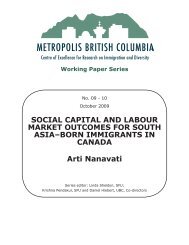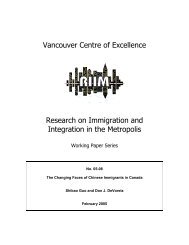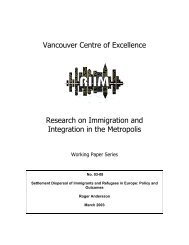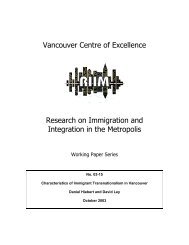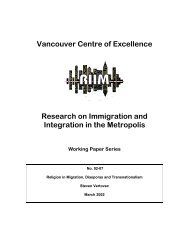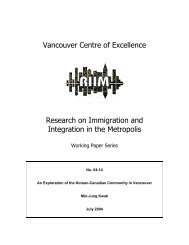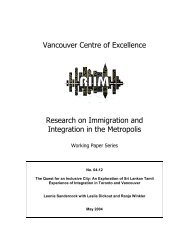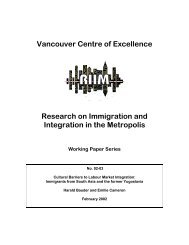Modernization and Global Restructuring of Women's Work
Modernization and Global Restructuring of Women's Work
Modernization and Global Restructuring of Women's Work
Create successful ePaper yourself
Turn your PDF publications into a flip-book with our unique Google optimized e-Paper software.
11<br />
Scene One: Place <strong>of</strong> Birth<br />
I was born in a city called Riyat that is located in the x part <strong>of</strong> Iran where the weather<br />
is very hot in summer <strong>and</strong> humidity is high, too. This makes breathing extremely<br />
difficult, as there is no air conditioner.<br />
Descriptions <strong>of</strong> birthplaces have served as entry points into the life worlds <strong>of</strong> people. Nadia’s<br />
description suggests two readings. At one level she wants to educate the Canadian people about Iran<br />
knowing full well that they know next to nothing about her country <strong>of</strong> birth, its way <strong>of</strong> life, its culture,<br />
literary tradition <strong>and</strong> history – let alone the fine scholarship produced by women over the last one<br />
hundred <strong>and</strong> fifty years. To compound the situation, Nadia (including other Iranian women) is<br />
concerned about the presence <strong>and</strong> circulation <strong>of</strong> distorted script among the media, the lay people <strong>and</strong><br />
within the social service sector. The parameters <strong>of</strong> the script are: Iranian people are uncivilized,<br />
backward <strong>and</strong> oppressive to their women (the Orientalist discourse). In giving a name to her place <strong>of</strong><br />
birth, Nadia <strong>of</strong>fers “a lesson in geography” – a sense <strong>and</strong> a feel <strong>of</strong> where she is from. Simultaneously,<br />
she introduces the reader to a second theme that on the surface refers to a lack – the absence <strong>of</strong> air<br />
conditioner, a symbol <strong>of</strong> modernization. It is important to note that Nadia does not explain this lack in<br />
terms <strong>of</strong> the Western master narrative <strong>of</strong> underdevelopment. She focuses on asymmetrical relations <strong>of</strong><br />
power as evident in her comment: “It is only in the oil refineries where the Europeans worked that air<br />
conditioners were available.”<br />
Nadia is well aware <strong>of</strong> the uneven state-initiated modernization <strong>of</strong> Iran: the urban centres<br />
“benefited” from the modern infrastructure <strong>of</strong> schools, hospitals, <strong>and</strong> communication systems. In<br />
contrast, the rural areas were increasingly defined to represent the opposite image <strong>of</strong> the urban:<br />
“undeveloped <strong>and</strong> backward.” Middle Eastern <strong>and</strong> Iranian feminist scholars have emphasized the<br />
point that the state’s project <strong>of</strong> modernizing has never been free <strong>of</strong> ruptures, gaps <strong>and</strong> contradictions.<br />
Sullivan’s (1998) example on the literary campaign for rural women is particularly illustrative.<br />
Sullivan draws our attention to the irony <strong>of</strong> making village girls sleep on the bunk beds in<br />
English-style boarding schools. The girls occupying the top <strong>of</strong> the bunk beds were tied with chador<br />
(cloth for veiling that the Shah had outlawed in 1934) to prevent them from falling:<br />
The image <strong>of</strong> the women bound to her bed with the veil in the larger cause <strong>of</strong><br />
progressive rights <strong>and</strong> freedoms, a paradox <strong>of</strong> modernity captures the simultaneity <strong>of</strong><br />
modernity <strong>and</strong> its underside, <strong>of</strong> the forces <strong>of</strong> reason <strong>and</strong> their bondage, <strong>of</strong> the<br />
necessary reconstruction <strong>of</strong> identity <strong>and</strong> the loss <strong>of</strong> community; it bears witness to<br />
modernity as its own gravedigger (ibid: 224).



